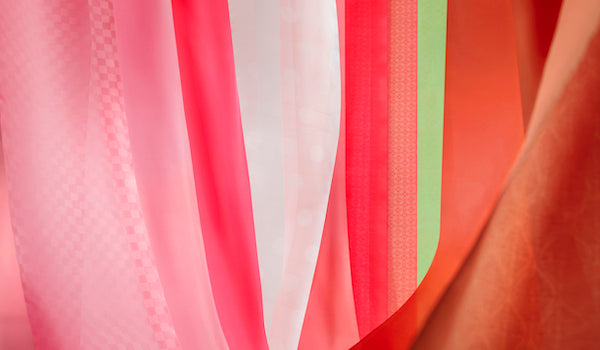
Living Colour

Before I begin my message this week I would like to thank everyone who has contributed to our Kickstarter campaign. I am truly grateful. So far we have £11,124
In 2006 we featured the work of Japanese master dyer Yoshioka Sachio (read the article here) and I have followed his work ever since. Last week, I was lucky enough to meet him at the opening of his exhibition, Living Colour at Japan House. The exhibition recreates the language of Kasane, a concept of layering colours first seen in the court fashions of Heian-period Japan (794-1185 CE), which still resonates with Japanese sensibilities today and the desire to reflect the changing seasons.

During the Heian period the most formal kimono, worn by the highest ranking women of the court, was the jūni-hitoe, literally ‘12-layered robe’. These kimonos were, in fact, made up of three, five, or up to eight layers. Dyed silk cloth was cut into sizes each slightly different from the other, producing small offsets at the neckline, cuffs and hems. The aristocracy delighted in using the colour combinations formed by these various layers to reflect the natural world around them, such as the plants blooming in each season, a particular occasion, or the wearer’s rank.
From light cherry blossom pinks to deep shades of indigo, Japan has a long history of using vivid colours. Using pigments harvested from the natural world to draw rich colours from his immediate surroundings, Yoshioka has embarked on a quest to revive Japan’s historic colours and methods of making. With the help of pre-19th-century historical documents and textile samples to recreate the palette of the Japanese court, Yoshioka’s work has revived this age-old craft from the brink of extinction.

At the Yoshioka Dyeing Workshop in Fushimi, a little way away from the centre of Kyoto city, skilled craftspeople dye cloth and washi in a variety of colours. Among them, purple, which requires exceptional skill, is entrusted to the oldest craftsmen who implicitly place their trust in the head of the workshop. ‘Living Colours’, introduces the daily workings of Sachio’s studio, his passion for age-old natural dyeing methods and the plans for the future of the craft in Fushimi. Yoshioka has exhibited his work throughout Japan and internationally and has collaborated with CHANEL to produce red lipsticks. He received the Kikuchi Kan Award in 2010 and Japan Broadcasting Corporation (NHK) Cultural Award in 2011.
Living Colours: Kasane – the Language of Japanese Colour Combinations is on display in the Gallery at Japan House until 19 May 2019.
